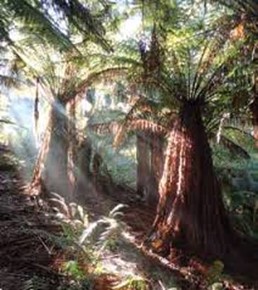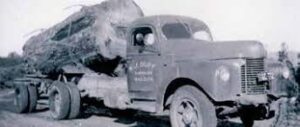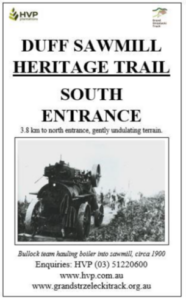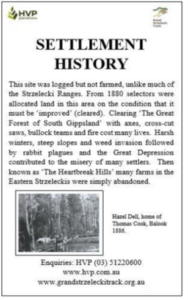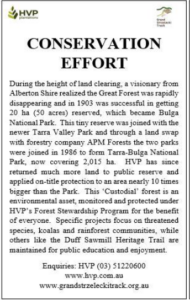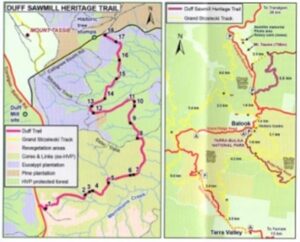DUFF SAWMILL HERITAGE TRAIL
Introduction
The Duff Sawmill Heritage Trail includes good examples of the forest mosaic landscape in the eastern Strzelecki Ranges, following a colourful settlement and sawmilling history that took place from the late 19th to mid-20th centuries. It includes remnant old growth eucalypts, regenerating rainforest, a beautiful Blackwood forest and examples of commercial timber plantations. Now incorporated into the Grand Strzelecki Track, the trail is a gently undulating walk that can be completed in about 1.5 hours (with room to park vehicles at both ends) or as part of the more challenging 18.3 kms (6-7 hours) Mount Tassie Loop starting and finishing in Balook. Alternatively, just continue 2.3 kms to the picnic area on Mount Tassie for panoramic views of the Strzelecki Ranges, Latrobe Valley and Wilson’s Promontory. The trail passes through private land owned and managed by HVP Plantations and is maintained by HVP Plantations for public appreciation of our cultural and environmental heritage.
Early settlement
In the earliest of times, the Strzelecki Ranges were densely forested, seasonally visited by indigenous people (the Gunaikurnai), disturbed only by rare fires that devastated the old and created new, vigorous eucalypt forests. Then in the 1840’s came the European explorers (Strzelecki and McMillan) who gave the area their names, as well as Bulga and Tarra reflecting the original inhabitants of the challenging country. Settlers followed the explorers, first along the river flats, then by the 1870’s into the hills. The deep soils and high rainfall supporting the ‘Great Forest of South Gippsland’ gave promise of good farmland.
Duff Sawmill
Duff Sawmill was one of the many sawmills in the area that relied on the large Mountain Ash to supply timber demands for a growing Victoria. The sawmill was located near Mount Tassie and sourced timber from the surrounding forests in the 1940’s and 1950’s. Little remains of the sawmill, but the stumps of trees used to supply logs can be seen along the trail. Board holes in the stumps allowed axemen and sawyers to climb to cut the trees above the buttresses. Logs were skidded along tracks by horse or tractor to the sawmill. The trail links various parts of these old tracks, many of which have now overgrown with ferns, Mountain Ash and Sassafras.
The trail reflects the story of this settlement and provides an insight into what is seen in the Strzelecki Ranges today. Early settlement involved sawmilling the giant trees for timber and clearing the forests for farming, often using fire as a tool. Tough people were required. By the 1950’s only a few small areas remained intact. The success of settlement varied. Small sawmills flourished, then declined, as logs became too difficult to extract. Farmers facing isolation, climatic hardship, rabbit plagues, fires, weed invasion and the Great Depression abandoned their farms, leaving a mosaic of logged remnant forest, regrown scrub areas, cleared grassland and areas of regrowth forest. A government plantation program began in 1948, replanting the early logged and abandoned settlement areas once more to trees. These plantations now form the basis of an ongoing timber industry.
Natural history
Interpretive signage along the trail describes the natural and settlement history of the area, as well as current conservation efforts. Some giant old growth trees and regenerating rainforest can be seen. A popular feature is the enchanting Blackwood forest, believed to be former rainforest where Blackwood has replaced the usual canopy of Myrtle Beech and Sassafras due to fire long ago. The hanging mosses, ferns and moss-covered logs provide a wealth of photo opportunities.
The aim of the project included:
1. To provide an informative narrative about the natural and cultural heritage of the eastern Strzelecki Ranges and showcase HVP Plantations Forest Stewardship Program.
- To contribute to tourism potential of the Grand Strzelecki Track and the Balook area.
Interpretive signage project
Implemented in 1998, interpretive signage was redesigned and installed in 2016. Partners in the signage upgrade project were Balook and District Residents Association (BADRA), who arranged printing of updated brochures with a grant from Wellington Shire. The project cost was $6,000.
The trail receives a higher level of visitation than any other part of the Grand Strzelecki Track outside of Tarra-Bulga National Park. Part of the attraction for visitors is learning about the colourful sawmilling and settlement history of the area, as well as its natural history and environmental values. Interpretive signage was outdated and not sufficiently informative.
In 2016, 18 new interpretive signs were designed and installed along the trail. The signs feature a selection of historic photographs and cover the settlement and sawmilling history, indigenous history, natural history including ‘The Great Forest of South Gippsland’ and the impacts of fires, current environmental values and HVP Plantations Forest Stewardship Program. The project included redesigning the existing brochure, which was printed for public distribution by Balook and District Residents’ Association with a grant from Wellington Shire Council.
Interpretive signs (refer to the numbers on the map)
- South entrance (3.8 kms to north entrance)
- Regenerating Cool Temperate Rainforest
- Mountain Ash regrowth
- Timber extraction
- Fire history
- Old growth Mountain Ash
- Merriman Creek rainforest
- Settlement history (1.9 kms, half way point)
- The Blackwood Forest
- Conservation effort
- Forest birds
- Forest mammals
- Plantation history
- Aboriginal history
- Springboard stump
- Trails of early settlement
- Weed invasion
- North entrance (3.8 kms to south entrance)
Recent history
In 2008, the land through with the southern half of the trail passes was included in an agreement between HVP Plantations and the Victorian government to progressively transfer 8,000 hectares of eucalypt plantation and native forest land into State ownership, creating a reserve encompassing and linking core areas of biodiversity (the Cores and Links). This will form a permanent corridor between Tarra-Bulga National Park and the Merrimans Creek rainforest. Single species plantation has been gradually harvested and regenerated with the diverse native forest prior to transfer of the land. The agreement also included the legal protection of another 18,000 hectares of privately managed native forest, through which the northern half of the trail passes.
The Black Saturday fire on 7th of February 2009 impacted part of the trail including the historic tree stumps, but the majority was spared. In places, you will see some regeneration from this fire, which is an infrequent event in this normally wet environment.
Plantations
Plantations of Pine and Mountain Ash were established on land abandoned by settlers. Plantations are harvested and replanted every 25 to 30 years to provide a sustainable source of timber for the community and local industry. Remnants of native forest are closely interspersed with Pine and Hardwood Plantations in the Strzelecki Ranges.
HVP Plantations only harvests timber from sustainable plantations and has Forest Stewardship Council certification. The 35,000 hectares of native forest within HVP Plantations Strzelecki Ranges estate is managed for conservation purposes.
